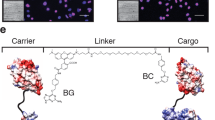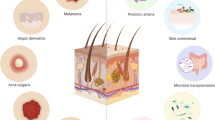Abstract
Durable gene delivery to human skin is necessary for lasting correction of human genetic skin disease. Current cutaneous gene-delivery strategies, however, have achieved only transient gene expression, often only within a small percentage of tissue cells. The recent inability to sustain phenotypic correction of human genetic skin disease due to loss of therapeutic gene expression in regenerated epidermal tissue has highlighted this current limitation. In an effort to surmount this problem, we have generated gene delivery vectors that produce more durable gene delivery in human skin tissue in vivo
This is a preview of subscription content, access via your institution
Access options
Subscribe to this journal
Receive 12 print issues and online access
$209.00 per year
only $17.42 per issue
Buy this article
- Purchase on Springer Link
- Instant access to full article PDF
Prices may be subject to local taxes which are calculated during checkout
Similar content being viewed by others
References
Cheng, J., Syder, A.J., Yu, Q.C., Letai, A., Paller, A.S. and Fuchs, E. 1992. The genetic basis of epidermolytic hyperkeratosis: a disorder of differentiation-specific epidermal keratin genes. Cell 70: 811–819.
Coulombe, P.A., Hutton, M.E., Vassar, R. and Fuchs, E. 1991. A function for keratins and a common thread among different types of epidermolysis bullosa simplex diseases. J. Cell Biol. 115: 1661–1674.
Uitto, J. and Pulkkinen, L. 1996. Molecular complexity of the cutaneous basement membrane zone. Mol. Biol. Rep. 23: 35–46.
Rothnagel, J.A., Dominey, A.M., Dempsey, L.D., Longley, M.A., Greenhalgh, D.A., Gagne, T.A. et al. 1992. Mutations in the rod domains of keratins 1 and 10 in epi-dermolytic hyperkeratosis. Science 257: 1128–1130.
Huber, M., Rettler, I., Bernasconi, K., Frenk, E., Lavrijsen, S.R., Ponec, M. et al. 1995. Mutations of keratinocyte transglutaminase in lamellar ichthyosis. Science 267: 525–528.
Russell, L.J., DiGiovanna, J.J., Rogers, G.R., Steinert, P.M., Hashem, N., Compton, J.G. and Bale, S.J. 1995. Mutations in the gene for transglutaminase 1 in autosomal recessive lamellar ichthyosis. Nature Genet. 9: 279–283.
Choate, K.A., Medalie, D.A., Morgan, J.R. and Khavari, P.A. 1996. Corrective gene transfer in the human skin disorder lamellar ichthyosis. Nature Med. 2: 1263–1267.
Freiberg, R.A., Choate, K.A., Deng, H., Alperin, E.S., Shapiro, L.J. and Khavari, P.A. 1997. A model of corrective gene transfer in X-linked ichthyosis. Hum. Mol. Genet. 6: 937–933.
Lu, B., Federoff, H.J., Wang, Y., Goldsmith, L.A. and Scott, G. 1997. Topical application of viral vectors for epidermal gene transfer. J. Invest. Dermatol. 108: 803–808.
Fenjves, E.S., Yao, S.N., Kurachi, K. and Taichman, L.B. 1996. Loss of expression of a retrovirus-transduced gene in human keratinocytes. J. Invest. Dermatol. 106: 576–578.
Gerrard, A.J., Hudson, D.L., Brownlee, G.G. and Watt, F.M. 1993. Towards gene therapy for haemophilia B using primary human keratinocytes. Nature Genet. 3: 180–183.
Setoguchi, Y., Jaffe, H.A., Danel, C. and Crystal, R.G. 1994. Ex vivo and in vivo gene transfer to the skin using replication-deficient recombinant adenovirus vectors. J. Invest Dermatol. 102: 415–421.
Choate, K.A. and Khavari, R.A. 1997. Sustainability of keratinocyte gene transfer and cell survival in vivo. Hum. Gene Ther. 8: 895–901.
Hoeben, R.C., Migchielsen, A.A., van der Jagt, R.C., van Ormondt, H., and van der Eb, A.J. 1991. Inactivation of the Moloney murine leukemia virus long terminal repeat in murine fibroblast cell lines is associated with methylation and dependent on its chromosomal position. J. Virol. 65: 904–912.
Challita, P.M. and Kohn, D.B. 1994. Lack of expression from a retroviral vector after transduction of murine hematopoietic stem cells is associated with methylation in vivo. Proc. Natl. Acad. Sci. USA 91: 2567–2571.
Wolffe, A.P. 1992. New insights into chromatin function in transcriptional control. FASEB J. 6: 3354–3361.
Chakraborty, A.K., Zink, M.A., Boman, B.M. and Hodgson, C.R. 1993. Synthetic retrotransposon vectors for gene therapy. FASEB J. 7: 971–977.
Choate, K.A., Kinsella, T.M., Williams, M.L., Nolan, G.R. and Khavari, P.A. 1996. Transglutaminase 1 delivery to lamellar ichthyosis keratinocytes. Hum. Gene Ther. 7: 2247–2253.
Faustinella, F., Kwon, H., Serrano, F., Belmont, J.W., Caskey, C.T. and Aguilar-Cordova, E. 1994. A new family of murine retroviral vectors with extended multiple cloning sites for gene insertion. Hum. Gene Ther. 5: 307–312.
Hantzopoulos, R.A., Sullenger, B.A., Ungers, G. and Gilboa, E. 1989. Improved gene expression upon transfer of the adenosine deaminase minigene outside the transcriptional unit of a retroviral vector. Proc. Natl. Acad. Sci. USA 86: 3519–3523.
Miller, A.D., Jolly, D.J., Friedmann, T. and Verma, I.M. 1983. A transmissible retro-virus expressing human hypoxanthine phospho-ribosyltransferase (HPRT): gene transfer into cells obtained from humans deficient in HPRT. Proc. Natl. Acad. Sci. USA 83: 4709.
Wolffe, A.P. 1994. Gene regulation. Insulating chromatin. Curr. Biol. 4: 85–87.
Kalos, M., Fournier, R.E., Pearce, D. and Yamamoto, K.R. 1995. Position-independent transgene expression mediated by boundary elements from the apolipoprotein B chromatin domain Mineralocorticoid and glucocorticoid receptor activities distinguished by nonreceptor factors at a composite response element. Mol. Cell Biol. 15: 198–207.
Medalie, D.A., Eming, S.A., Tompkins, R.G., Yarmush, M.L., Krueger, G.G. and Morgan, J.R. 1996. Evaluation of human skin reconstituted from composite grafts of cultured keratinocytes and human acellular dermis transplanted to athymic mice. J. Invest. Dermatol. 107: 121–127.
Murphy, G.F., Flynn, T.C., Rice, R.H. and Pinkus, G.S. 1984. Involucrin expression in normal and neoplastic human skin: a marker for keratinocyte differentiation. J. Invest. Dermatol. 82: 453–457.
Fairley, J.A., Heintz, P.W., Neuburg, M., Diaz, L.A. and Giudice, G.J. 1995. Expression pattern of the bullous pemphigoid-180 antigen in normal and neoplastic epithelia. Br. J. Dermatol. 133: 385–91.
Orkin, S.H. and Motulsky, A.G. 1995. Report and recommendations of the panel to assess the NIH investment in research on gene therapy. http: //www.nih.gov/news/panelrep.html.
Taichman, L.B. 1994. Epithelial gene therapy, pp. 543 in The keratinocyte handbook. Leigh, I., Lane, B., and Watt, F. (eds.). Cambridge University Press, Cambridge, UK.
Khavari, P.A. and Krueger, G.G. 1997. Cutaneous gene therapy. Dermatol. Clin. 15: 27–35.
Palmer, T.D., Rosman, G.J., Osborne, W.R. and Miller, A.D. 1991. Genetically modified skin fibroblasts persist long after transplantation but gradually inactivate introduced genes. Proc. Natl. Acad. Sci. USA 88: 1330–1334.
Kinsella, T.M. and Nolan, G.R. 1996. Episomal vectors rapidly and stably produce high-titer recombinant retrovirus. Hum. Gene Ther. 7: 1405–1413.
Krall, W.J., Skelton, D.C., Yu, X.J., Riviere, I., Lehn, P., Mulligan, R.C. and Kohn, D.B. 1996. Increased levels of spliced RNA account for augmented expression from the MFG retroviral vector in hematopoietic cells. Gene Ther. 3: 37–48.
Rheinwald, J.G. and Green, H. 1975. Serial cultivation of strains of human epidermal keratinocytes: the formation of keratinizing colonies from single cells. Cell 6: 331–343.
Author information
Authors and Affiliations
Rights and permissions
About this article
Cite this article
Deng, H., Lin, Q. & Khavari, P. Sustainable cutaneous gene delivery. Nat Biotechnol 15, 1388–1391 (1997). https://doi.org/10.1038/nbt1297-1388
Received:
Accepted:
Issue Date:
DOI: https://doi.org/10.1038/nbt1297-1388
This article is cited by
-
GLI2 induces genomic instability in human keratinocytes by inhibiting apoptosis
Cell Death & Disease (2014)
-
A Deafness-Associated Mutant Human Connexin 26 Improves the Epithelial Barrier In Vitro
Journal of Membrane Biology (2007)
-
The zinc-finger transcription factor GLI2 antagonizes contact inhibition and differentiation of human epidermal cells
Oncogene (2004)
-
Divergent gene regulation and growth effects by NF-κB in epithelial and mesenchymal cells of human skin
Oncogene (2003)
-
Sustainable correction of junctional epidermolysis bullosa via transposon-mediated nonviral gene transfer
Gene Therapy (2003)



